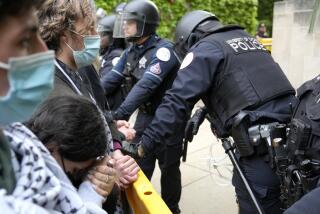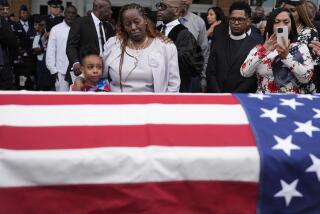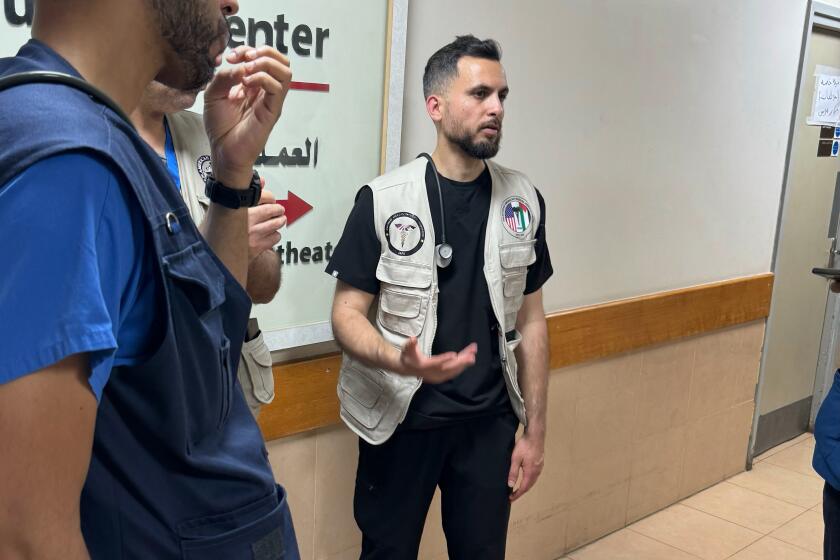Drug Suspect’s Yard Also a Grave
Amid surging violence fueled by the narcotics trade, police said Tuesday that they had unearthed the bodies of 11 men from the backyard of a suspected drug cartel operative here.
Mexican Atty. Gen. Rafael Macedo de la Concha said the dead were victims of an “all-out confrontation” between the Juarez cartel and one or more of its rivals -- fighting stirred up, he said, by a prolonged government crackdown on them all.
“The narco-traffickers are killing each other,” he said.
Discovery of the clandestine cemetery here followed a week of drug-related killings that left at least 18 people dead across Mexico.
Federal police found the remains behind a beige stucco house on a quiet cul-de-sac in a middle-class neighborhood. They dug up four bodies from Friday to Sunday. Seven more were found Monday after investigators wearing surgical masks ripped up a concrete patio.
Macedo said the dead could have been interred six months to a year ago. Several had been beaten and tortured, then strangled or suffocated, police said. Some were buried with plastic bags over their heads.
Authorities identified three of the dead but gave no other information about them.
The owner of the home, which was abandoned several months ago, was identified by Mexican authorities as Humberto Santillan Tabares. They said he is a chief lieutenant of Vicente Carrillo Fuentes, a top figure in the Juarez cartel.
Mexican authorities ordered the home raided after sheriff’s deputies in El Paso, Texas, across the Rio Grande from Ciudad Juarez, arrested Santillan on Jan. 16. He had been indicted the previous month on charges of trafficking cocaine into the United States.
The accused man was identified in the U.S. indictment by two different names, Heriberto Santillan Tabares and Humberto Esteves-Lopez. But Mexican officials said they were certain he owned the burial ground.
Ciudad Juarez is infamous for the unsolved killings of hundreds of young women over the past decade. The bodies discovered in recent days represent another dark side.
The Juarez cartel is one of Mexico’s seven major rivals in a drug smuggling business worth an estimated $65 billion a year. A conduit of Colombian cocaine into the United States, it was once led by Amado Carrillo Fuentes, who became known as the “Lord of the Skies” for his skill at moving cargo on large airplanes and helicopters.
In 1997 he had a plastic surgeon in Mexico City change his appearance but died of complications from the procedure. His brother Vicente emerged as one of several key figures in a more fragmented cartel, Mexican officials say.
The drug boss’ death marked the start of a disintegration of Mexico’s cartels, which once respected each other’s turf and, according to critics of the government, enjoyed protection from the long-ruling Institutional Revolutionary Party, or PRI.
Starting in 1999, four other cartels -- based in Tijuana, Colima, Guadalajara and along the Gulf Coast -- lost their leaders to shootouts or prison and fell into disarray. In 2000, the election of President Vicente Fox ended 71 years of rule by the PRI and launched a federal clampdown on the cartels.
The result has been a violent destabilization of the narcotics trade.
Bruce Bagley, a professor of international studies at the University of Miami, estimates that 500 suspected traffickers have been killed in Mexico since 1998. What was once a relatively stable structure of parallel drug cartels, he said, has devolved into a hornet’s nest of feuding cartelitos, or mini-cartels.
“These people are willing to fight to the death over control of an industry that represents billions and billions of dollars,” Bagley said. The bodies in Ciudad Juarez, he added, “are just the tip of the iceberg. There are other graveyards along the border.”
Sigrid Arzt, an organized crime specialist at Mexico City’s Center of Economic Research and Teaching, said elements of the Juarez, Tijuana and Gulf cartels were vying for power in Ciudad Juarez.
“But there are no clear bosses,” she added. “These gangs used to have clear structures, but they have been pulverized. It is difficult to tell who exactly is fighting against whom.” Mexico is experiencing a particularly deadly period along the U.S. border and in the northwestern state of Sinaloa. Much of the violence is drug-related, officials said.
Last week, five people were killed near the coastal city of Mazatlan, in Sinaloa, and a former official with the attorney general’s office, as well as his bodyguard, were shot dead in a Tijuana bar. A shootout Sunday left three people dead in Nuevo Laredo, across the border from Laredo, Texas, where a drug gang apparently composed of Mexican army deserters began a violent campaign for control last year.
In radio interviews Tuesday, Macedo, the attorney general, and his top deputy on organized crime, Jose Luis Santiago Vasconcelos, depicted these killings as a product of vigorous law enforcement.
“This violence makes us all uneasy,” Santiago said. “But it is better to have these incidents, clashes over the application of the law, than to permit these gangs to operate in silence.”
Boudreaux reported from Mexico City, Hart from Ciudad Juarez and Gold from Houston.
More to Read
Start your day right
Sign up for Essential California for news, features and recommendations from the L.A. Times and beyond in your inbox six days a week.
You may occasionally receive promotional content from the Los Angeles Times.







